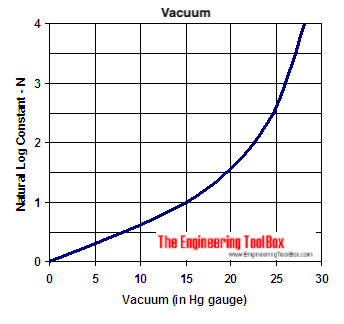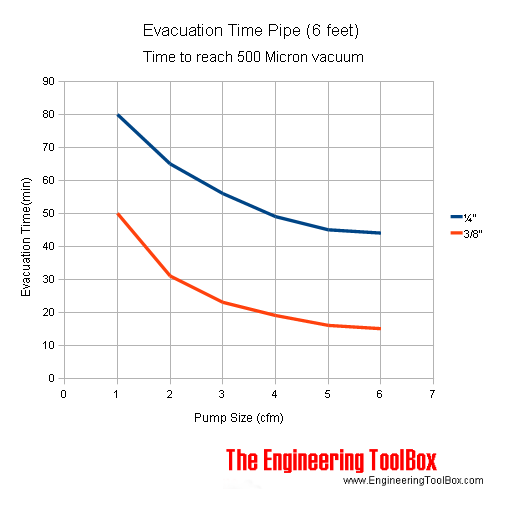Vacuum - Evacuation Time
Vacuum pumps - calculate flow rate and required evacuation time.
The evacuation time for a vacuum pump can be calculated as
t = V / q ln(p0 / p1) (1)
where
t = evacuation time (s)
V = enclosed evacuated volume (m3, cu.ft)
q = volume flow rate capacity of the vacuum pump (m3/s, cu.ft/s)
p0 = initialization pressure - normal atmospheric pressure (mbar, mmHg)
p1 = end vacuum pressure (mbar, mmHg)
Note! Leakage through sealing's etc. should be compensated by adjusting the volume flow rate of the vacuum pump.
(1) can be simplified to
t = V / q N (2)
where
N = natural log constant for the actual vacuum
N = 1 for vacuum up to 15 in Hg gauge
N = 2 for vacuum up to 22.5 in Hg gauge
N = 3 for vacuum up to 26 in Hg gauge
N = 4 for vacuum up to 28 in Hg gauge

Example - Vacuum Evacuation Time
Evacuation time of 1 m3 volume, evacuated to 500 mbar abs - vacuum pump volume flow capacity 0.1 m3/s - can be calculated as:
t = (1 m3) / (0.1 m3/s) ln((1000 mbar) / (500 mbar))
= 6.9 (s)
Evacuation to 100 mbar abs:
t = (1 m3) / (0.1 m3/s) ln((1000 mbar) / (100 mbar))
= 23 (s)
Evacuation to 10 mbar abs:
t = (1 m3) / (0.1 m3/s) ln((1000 mbar) / (10 mbar))
= 46 (s)
Vacuum Evacuation Time Calculator
The calculator below can be used to calculate the vacuum evacuation time.
Estimated Evacuation Time to Reach 500 Micron Vacuum - 6 feet pipe




